Ever since the early 1960's, Estes has dominated model rocketry - it is almost synonymous with the hobby itself. A few old timers fondly remember Centuri Engineering, noted for its exotic designs; little more than handful remember the smaller companies, such as FSI (Flight Systems Incorporated), Canaroc, RDC (Rocket Development Corporation), Competition Model Rocketry (CMR), Vashon, and others. Though they are mostly forgotten, these companies made valuable contributions to the hobby, often showing a level of innovation far beyond the Estes and Centuri offerings. For example, RDC produced the first composite motors, from which high power rocketry began. FSI made the first kit capable of breaking Mach 1, and Vashon came out with an innovative (albeit short-lived) line of freon powered rockets. These companies also had some pretty awesome designs - you can browse some of the old catalogs at
Ninfinger's site.
A few years back I was doing just that, and ran across the
Space Age Industries (SAI) catalog. I love egg lofters - egg lofting events are one of my favorite competition events. They pose a decent design/build challenge, and the potential for a catastrophic mess is high :) Anyway, this page in the catalog caught my eye:
 |
| Page from Space Age Industries catalog, published circa 1969 |
Who could resist an egg lofter with egg shaped fin tips and a name like "Hen Grenade"? I couldn't, so I set to searching for the plans on the Internet. I found
them at Ye Olde Rocket Plans, and gleefully realized that Semroc had the body tube size I needed (ST-18), along with the motor tube and centering rings. The nose cone was trickier, as I had no idea what the fiber material mentioned in the instructions was; besides I suck at making such things, and trembled at the thought of my improvised handiwork successfully containing an egg throughout a rocket flight. Fortunately, an alternative existed in my friend Gordon, "The Sandman", owner of Excelsior Rocketry. I put in an order for a custom part, and he fashioned this beautiful balsa nose:
 |
| Gorgeous Hen Grenade nose cone fashioned by Gordon Agnello at Excelsior Rocketry. |
With all the parts assembled, it was time to start the build. After I dutifully entered the Hen Grenade's name into my "Under construction" list on Ye Old Rocket Forum (YORF), I set out to cut the fins, knowing that the egg shaped tips were going to be a challenge with a hobby knife. This proved to be truer than I reckoned; I ended up giving up after several attempts that resulted in cut fingers and some blood loss. Deciding to wait until my skills at balsa cutting improved (and out of a sense of self preservation), I set the Hen Grenade parts up on a shelf, where they sat for years.
And where they would be setting still, if it were not for Gordon. I had ordered some decals for my Mean Machine clone (the topic of my "Bad Boy of Yesteryear" post), and Gordy, tired of seeing the Hen Grenade still in my "Under construction" list after a couple of years, sent along a fin set that he manufactured with his tools. The removal of the possibility of mutilation rekindled my desire to build this bird, and so construction has begun. I should have it ready to fly by Southern Thunder, and am excited about seeing this grand old design fly once more.
That, and the appeal of getting my fellow YORF'ers off my back…
















